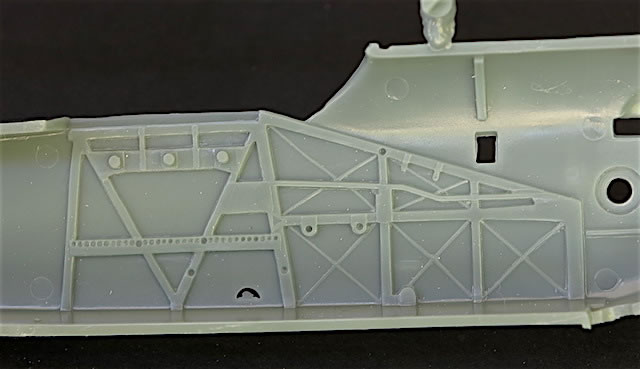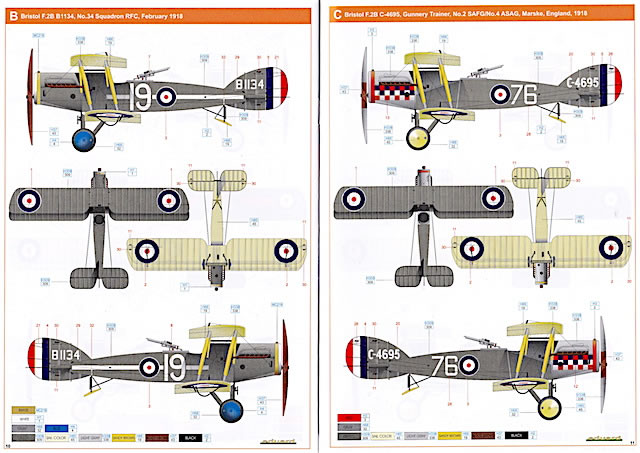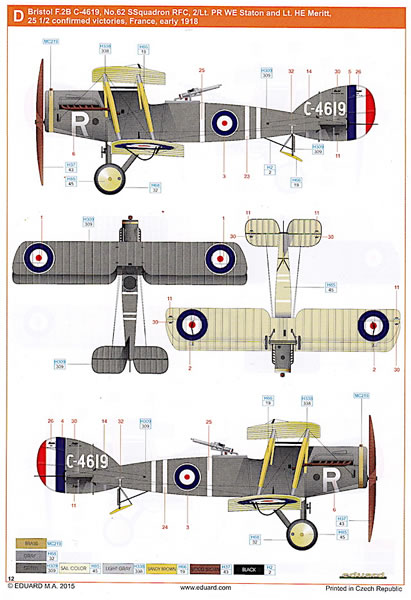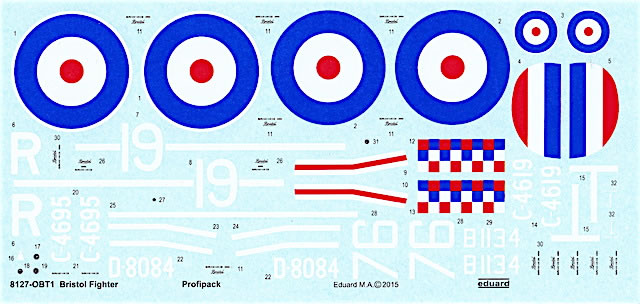|
Bristol F.2b Fighter
ProfiPACK

Eduard, 1/48 scale
S u m m a r y : |
Catalogue Number: |
Eduard Kit No. 8127 - Bristol F.2b Fighter |
Scale: |
1/48 |
Contents & Media: |
Approximately 163 grey coloured plastic parts (18 unused); 1 small sheet of clear plastic film; 1 fret of unpainted photo-etched parts; 1 decal sheet containing markings for 4 different aircraft; 12 page A5 instruction booklet with full colour painting and marking guide. |
Price: |
USD$39.95 plus shipping available online from Eduard’s website and specialist hobby retailers worldwide. |
Review Type: |
First Look |
Advantages: |
Accurate, well-moulded plastic parts; lots of photo-etched brass parts for additional detail; four interesting marking choices. |
Disadvantages: |
Minor sink marks on exterior of fuselage halves; rigging guide in kit instructions could be improved; blue in roundel decals looks a bit too light. |
Conclusion: |
This is another great re-release from Eduard’s 1/48 World War I stable. Minor niggles aside, the kit remains unsurpassed in this scale and builds into an excellent model. Highly recommended. |
Reviewed by
Brad Fallen

Eduard's 1/48 scale Bristol F.2B Fighter
is available online from Squadron.com for only USD$26.37!
The Bristol F.2b was one of the great British aircraft of World War I. Entering service in 1917, it was a manoeuverable two-seater that – flown aggressively – was a match for most German fighters. After the war it continued in RAF and Commonwealth service until the mid-1930s.
Eduard’s 1/48 Bristol F.2b series was launched in May 2005, overtaking Roden’s 2003 kit as the best quarterscale Brisfit. The original release contained four marking options but no photo-etched parts; these were in the Profipack boxing that followed a month later. There were a number of further releases, including a Night Fighter Profipack, colourful Limited Editions in 2006 and 2008, and a Weekend Edition in 2009. Revell also re-boxed the sprues with different decals in 2013.
All of these releases have been favourably received, with reviewers agreeing the kit is accurate and – within the constraints imposed by the original design – reasonably straightforward to build. Roger Fabrocini’s build from late 2005 shows what a good-looking model can be made from the kit.
Eduard has now released another F.2b Profipack, featuring a combination of markings from several earlier releases.
Also used again is Martin Novotny’s lovely box art, dated December 2003, which shows Dalrymple and Beagle’s Bristol Fighter (marking option A) flying alongside another F.2b.
Inside the box are four sprues of grey plastic that appear identical to those of earlier releases. Eduard’s moulds are still in good shape, as the quality of the parts is excellent. The only obvious imperfections are some sink marks on the outside of the starboard fuselage that correspond with internal structural detail. Some parts have a little flash, but nothing that can’t be dealt with quickly and easily.
Representation of detail on the larger parts, while mostly very good, is perhaps where this kit shows its age the most. The zigzag fabric stitching on the fuselage halves is effective, but some of the detail around the engine cowling looks a little soft. Rib detail on the wings, tailplanes and control surfaces is a bit exaggerated for my taste, and would benefit from a light sanding.
When Eduard launched the F.2b they billed it as “one of the most detailed WW I model kits ever made”, and in terms of 1/48 kits this claim still holds water. Nearly 150 plastic and over 80 photo-etched brass parts go into the build. Much of this detail is intended for the cockpit and patience here will bring rewards, as your work will be highly visible.

Cockpit construction is simplified by Eduard’s thoughtful moulding of the internal framework as part of the fuselage halves (sink marks notwithstanding), but still take care and do lots of test fitting. One example where this is a good idea is with the multi-part photo-etched wicker seat, which requires careful shaping and assembly; a plastic back up is provided, but this won’t look half as good as the etched parts. Another example is when replicating the varnished wood finish of the interior – it’s reasonably easy to get good results with oil paints but you need to allow a longer drying time than with enamels or acrylics.
A point to note about the photo-etched parts is that none are pre-painted – not even the seat harnesses – so careful painting is the order of the day.

Moving to the front of the aircraft, Eduard has represented the Brisfit’s Falcon engine by two blanking plates with cylinders moulded in relief. This is a simple but effective depiction in this scale, although it would be easy to add more detail if you wanted to.
The most daunting parts of biplane model assembly are the wing-to-fuselage and wing-to-wing joins, and this is especially so with the F.2b where the fuselage sits above the lower wing on four small struts. Fortunately Eduard has made these joins as simple as possible, with online build logs suggesting that all will go well if you follow the instructions and take your time. The upper and lower wings are both one-part mouldings, which ensures correct dihedral and helps greatly with alignment. Make sure you keep track of which wing struts go where – these are clearly marked on the instructions but will be easy to mix up, with exasperating consequences (something I know all about from a recent 1/32 build).
A full complement of ordnance and weapons is included, including 20lb Cooper bombs, 110/112lb HERL bombs and (depending on the aircraft you choose to model) single or double Lewis guns. If you don’t want to finish your model with bomb racks attached, you’ll need to fill in the 12 small pre-drilled holes on the lower wing.
The instructions are printed as a 12-page A5 booklet with largely black-and-white assembly sequences and a full-colour painting and marking guide. The A5 size is OK but given the complexity of the construction process, I can’t help but think everything would be clearer in the larger A4 format.
That said the assembly illustrations are well done with part numbers and colour call outs clearly indicated. There aren’t many differences between the aircraft represented but where there are – for example the extended exhausts of marking option C – the instructions point this out.
One section of the instructions Eduard could improve is the rigging guide. Like most World War I British aircraft, the Brisfit had a complex arrangement of double- and single-rigging wires. These add considerable character to a finished model but can be daunting to the uninitiated. An important starting point is an accurate illustration of what you’re up against – and Eduard’s guide is a bit lacking in this area. Most significantly, there is no indication of which wires are double and which are single; the location of some attachment points is also imprecise. A better starting point than the kit guide is the relevant page of Wingnut Wings’ instructions for its gorgeous 1/32 F.2b; there are also plenty of photos online. A final point on the rigging is that you will need to drill your own holes for the attachment points – not hard to do, but easier when you know where the holes have to be.
The painting and marking guide is typically comprehensive, with four-view drawings of each option and decal locations and paint colours clearly pointed out.
Markings
The four marking options are finished in PC10 over clear-doped linen. This sounds drab but in my experience PC10 is a great ‘colour’ to work with – there were many variations in tone and it’s a great canvas for creative shading and weathering.
On top of this, Eduard has chosen aircraft with a variety of colourful markings that will stand out against the subdued base colour.
-
D-8084/‘T’, flown by Captain Sydney Dalrymple and 2nd Lieutenant C. Beagle of No.139 Squadron, Royal Air Force, Italy, August 1918. This F.2b survivor is the most colourful of the options on offer, with large red sections on the upper wing and a red and white band around the rear fuselage.
-
B1134/‘19’ of No.34 Squadron, Royal Flying Corps, February 1918. This machine had a white stripe along each side of the fuselage, and coloured wheel hubs that Eduard has represented as blue.
-
C4695/‘76’ of 4 (Auxiliary) School of Aerial Gunnery/No.2 School of Aerial Fighting and Gunnery/2 Fighting School, Marske, England, 1918. This trainer had colourful red, white and blue checkerboards painted on the side engine cowlings.

-
C-4619/‘R’ flown by 2nd Lieutenant William E. Staton and Lieutenant Horace E. Merritt, No.62 Squadron, RAF, France, early 1918. The comparatively subdued colour of this F.2b is more than made up by its history as the mount of William Ernest Staton – Word War I ace, World War II pathfinder pioneer and POW, and British Olympian.

The decals have been produced by Eduard and look okay except for the blue of the roundels, which seems a bit light to me. Apart from this they are well printed and will need to be applied to a very high gloss surface, as most the codes, numbers and fuselage bands have large amounts of carrier film.

If I were building one of the options with fuselage bands, I’d probably paint these rather than use the decals.
This is yet another great 1/48 World War I re-release from Eduard. The kit has a couple of minor shortcomings, but it remains unsurpassed in this scale and builds into an excellent model. I can’t stress enough that the key to success here is patience – take your time, don’t cut corners and you’ll get a great result. Highly recommended.
Thanks to Eduard for the sample.
Review Text Copyright © 2016 by Brad Fallen
Page Created 25 February, 2016
Last updated
25 February, 2016
Back to HyperScale Main Page
Back to Reviews Page

|
